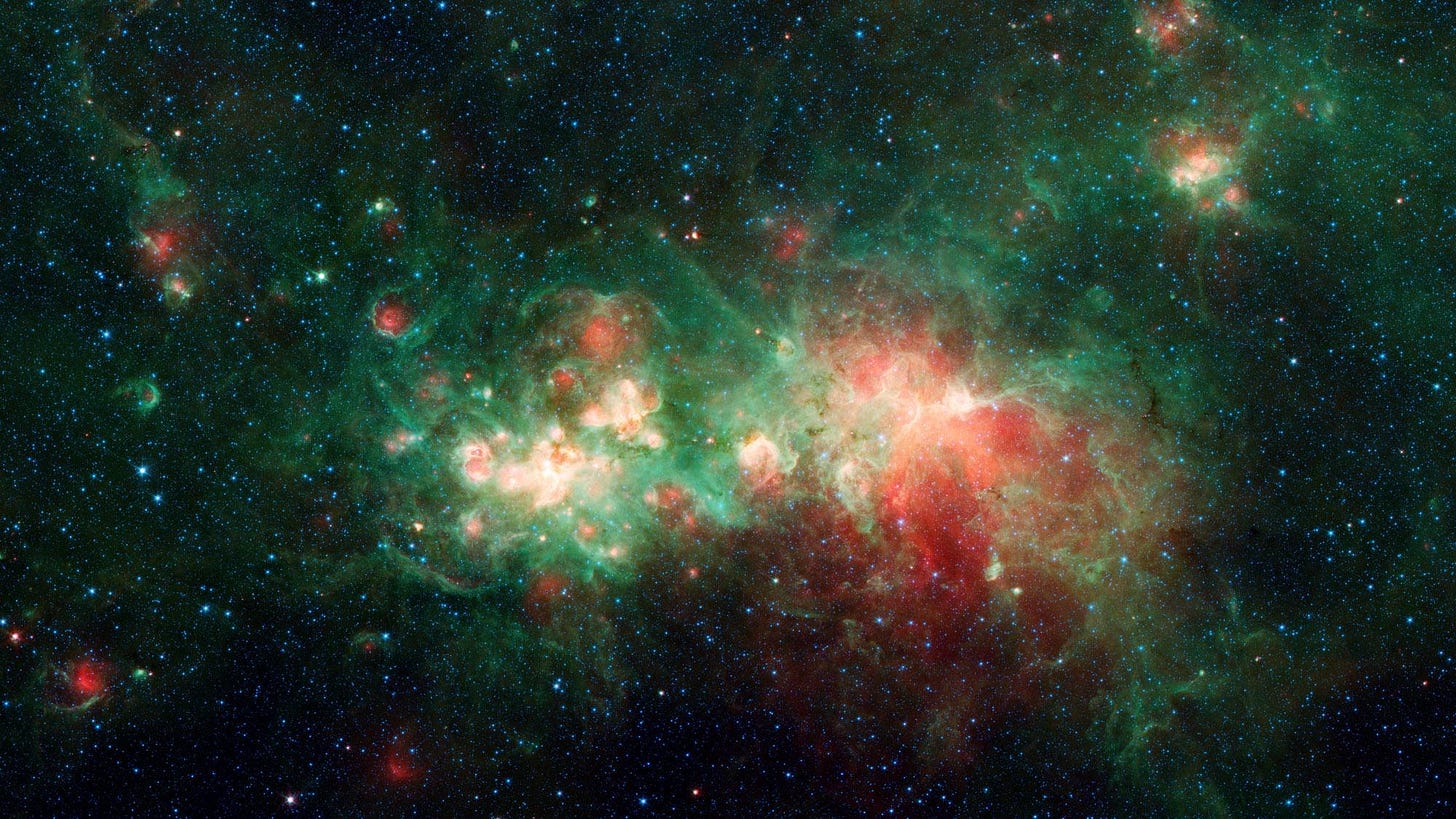Ferns, Fibonacci, and the interconnectedness of all things
What we can learn from nature’s patterns, changing our perspective, and David Bohm’s theory of the implicate order
After reading Ali’s newsletter about the overview effect—the transcendent experience astronauts have when viewing the Earth from space—I found myself thinking about how we can find similar revelations here on Earth. While the vastness of space is almost impossible to comprehend, there’s a whole universe of detail to explore here on Earth if we zoom in and take a closer look.
Moving from the cosmos to the ground beneath our feet, it becomes clear: everything is interconnected.
I like to walk on the trails near my house. They change with the seasons. In the spring, the woods are blanketed with tiny yellow wildflowers. After a heavy rain, the trails are muddy and boggy, and it's all I can do not to get stuck (and I’ve gotten stuck!) During some parts of the year, everything is green. At other times, everything is muted and brown. Year after year, the seasons follow a pattern.
There's a stretch of trail dotted with ferns, with their unfurling, symmetrical patterned leaves. They catch my eye with their uncanny uniformity and structure. Each frond that emerges from a fern is a mirror image of the fern as a whole. This is what's known as self-similarity, where an object contains the same level of detail at multiple scales.
This self-similarity isn't unique to ferns. It's a fundamental principle that appears throughout nature.
You’ll see these self-similar patterns in the branches of a tree and even the veins on the leaves of that tree. You’ll see the same pattern in the branching of rivers, streams, and creeks. You’ll see it in the human body in the vascular system, the nervous system, and the bronchial system in the lungs. Zoom out, and you'll find it in images of galaxies and bolts of lightning. Zoom in, and you'll see it in the structure of neurons in our brains.

My curiosity about these patterns led me to learn more about the Fibonacci sequence, a mathematical equation and spiral growth pattern found throughout nature, at every level.
You may have seen it in…
A pinecone
The petals of a flower
The seed arrangement on a sunflower
The spiral of a nautilus shell (or hurricane or galaxy)
The whipping winds of a tornado or watching water go down the drain
The Fibonacci sequence of numbers looks like this:
0, 1, 1, 2, 3, 5, 8, 13, 21…
Each third number represents the sum of the previous two numbers.
E.g., 0 + 1 = 1, 1+1 = 2, 2+3 = 5, and so on.
At first glance, it may look like simple arithmetic. This plus that equals this. But it’s much more than that. It is a formula that guides nature to create efficient and aesthetically beautiful structures. These rhythmic patterns are intelligently designed to maximize resources, to encourage growth, and to adapt to changing environments.
We are not separate from nature. We can find hints of the Fibonacci sequence mirrored in our own lives when we zoom in on how we learn, grow, and become who we are.
My son is entering his second year of piano lessons. What started as single notes played one by one has advanced into multiple notes played simultaneously at different speeds. His warmups are more complex, covering wider swathes of the keyboard. He only gets better if he continues to practice.
He is learning through repetition. Once he masters a pattern, his teacher gives him something more complex to work on.
We do this, too. We have a foundation of skills, and we may continue to build upon them or add entirely new skills. The same goes for habits. Growth results when we repeat the pattern and allow, and even invite, complexity.
Just as we can observe these growth patterns in nature and in learning new skills, we can also turn our attention inward to uncover the rhythms and structures that shape our own lives and identities.
What might zooming in on yourself look like? You can start by taking the time to reflect on your life and what makes you you. This could mean taking inventory of your experiences, interests, and the memories that define you. It could be observing the objects, clothes, feelings, or memories that permeate the space you inhabit. It can be helpful to act like a detective and step outside of yourself. Get curious about this person (that person is you).
Think about these questions:
Who am I? What do I care about? What matters to me?
As themes emerge, you can zoom out and take a wider view of your life, your choices, your community, and the world you have created for yourself. Notice what patterns emerge from this perspective and how they relate to where you started.
Look for the relationships and interconnectedness in the patterns that emerge from each perspective.
Be on the lookout for patterns that may not have followed a neat, predictable sequence. Notice the interplay between structure and randomness. Notice the tension, or rather the balance, between chaos and order. Patterns often emerge amidst chaos.
What begins as chaos—sometimes explosively, like the birth of a star—eventually finds rhythm and order over time and through many iterations. Much like learning a new skill where we may stumble through our first steps, hit the wrong keys, or make a few questionable choices.
This is the process of finding the patterns that help us develop, adapt, and grow. We constantly evolve and learn, discarding what is unnecessary and advancing through our own personal equation.

The patterns we observe in nature and our lives hint at a deeper, underlying order in the universe. This idea resonates with the work of physicist David Bohm, who proposed a theory that challenges our conventional understanding of reality.
Bohm introduced the concept of the "implicate order," a deeper, more fundamental level of reality where everything in the universe is interconnected and enfolded into everything else. According to Bohm, what we perceive in our everyday lives—the "explicate order"—is merely a surface manifestation of this deeper reality.
Much like the self-similar patterns we see in ferns, rivers, and galaxies, Bohm suggested that the universe operates as a coherent whole, with each part reflecting and containing the essence of the entire system. He used the analogy of a hologram to explain this idea: just as every part of a hologram contains the entire image, every part of the universe reflects the whole.
Bohm’s ideas invite us to reconsider the apparent separateness of objects and experiences in our lives. When we look closely—whether at the intricate patterns of a fern or the complex interplay of events in our lives—we can begin to see the underlying unity that connects all things. This perspective encourages us to view the world with a sense of curiosity and wonder, recognizing that each part is deeply connected to the whole.
Opening ourselves up to this interconnectedness changes how we perceive the world around us, encouraging us to be curious observers of our environment and our place within it.
Once you start noticing these patterns, you’ll see them everywhere. You will become a pattern hunter, finding connections across all things, people, and concepts. Your creativity and sense of possibility will expand to the infinite reaches of the universe.
As you move through your life, whether it feels challenging or in flow, consider that each part is connected to the whole, that each experience is part of something greater, and that there is no separation—not from nature, the universe, or any aspect of your life. This perspective reaches far beyond simply zooming in or zooming out. It is a way to trust that no matter where you are, you’re in the right place, and you’re right on time.
The next time you encounter a pattern in nature or your own life, take a moment to reflect on how it connects to the greater whole.
You may be surprised by what you discover.
Questions for Reflection:
What patterns have you noticed in your own life or environment that you hadn't paid attention to before?
How might viewing your life through the lens of the Fibonacci sequence, following the equation of incremental growth, change your perspective on your personal evolution?
In what ways do you see the interplay of chaos and order in your own life experiences? Which parts feel chaotic? Which parts feel orderly?
How does Bohm's idea of the implicate order and the interconnectedness of all things resonate with your own beliefs or experiences?
What new possibilities might open up if you started viewing challenges or obstacles as part of a larger, interconnected pattern rather than isolated events?





Beautiful. I love the fibonacci sequence, phyllotaxis, and the golden section. I once brought a pineapple to a client meeting to start the conversation about how everything is connected. :)
This reminds me of Powers of Ten! Fractal patterns, and how we think about change in similar or different ways across macro and micro. https://youtu.be/0fKBhvDjuy0